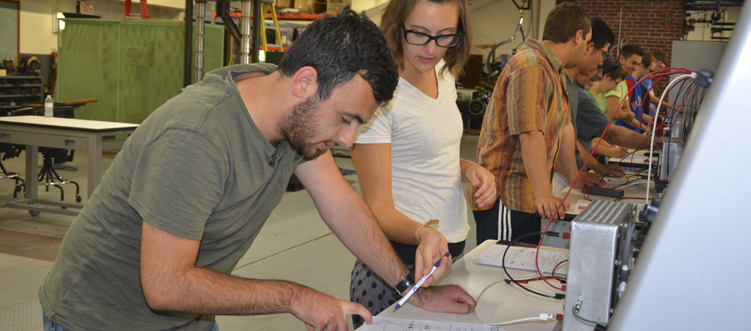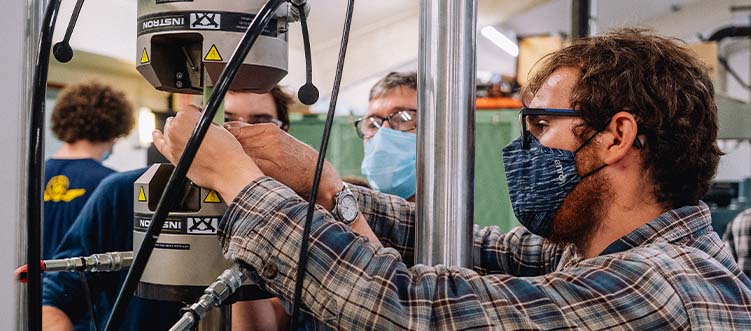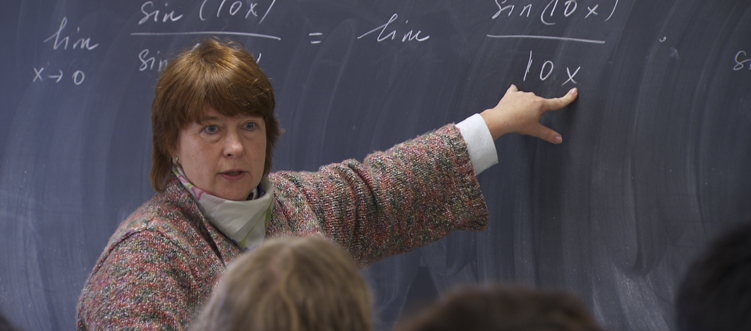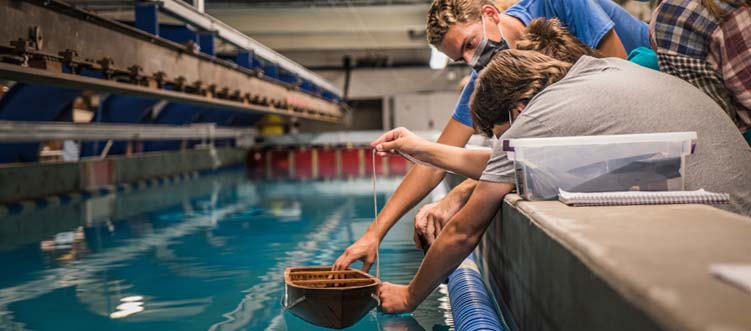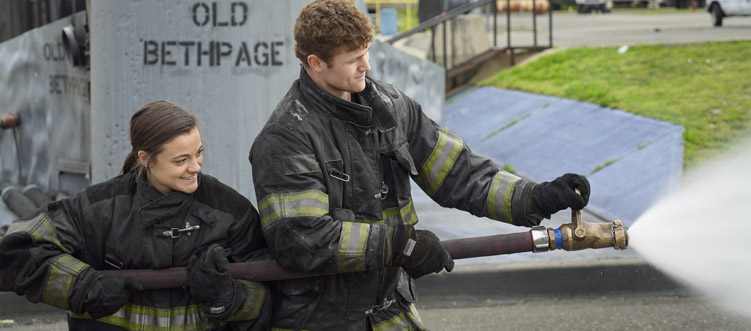At Webb, You’ll Receive a Top-Notch, Amazingly Versatile Education.
Our curriculum is completely different than any other educational setting. Through our refreshing systems approach, we focus on the quality and depth of engineering education so that our graduates can truly “hit the ground running” after graduation – whether in a full-time engineering role or through continued education at a premiere graduate school. You’ll be uniquely prepared for whatever comes next for you because of your time at Webb.
Professor Martin
The increasing use of electrical and electronic equipment in modern vessels makes necessary a more thorough treatment of electrical and electronic engineering than is customary in a non-electrical engineering curriculum. An intensive, analytical and practical course in electrical circuits and electronics is followed by a study of electro-mechanical devices and control systems. Marine applications are given where possible.
EE1: ELECTRICAL ENGINEERING I – CIRCUITS AND ELECTRONICS
Circuit topics include steady analysis of both single-phase and three-phase A/C, with a focus on power calculations including load analysis. Wave-shaping circuits, filters, and resonance are introduced. Electronics topics include solid state diodes, transistors, and operation amplifiers. Digital electronics topics including logic circuits and integrated circuits are introduced. Two hours of class and two hours of laboratory per week in the first semester.
EE2: ELECTRICAL ENGINEERING II – MACHINES AND CONTROLS
This course covers the principles of electro-magnetic devices and steady-state performance of transformers and rotating machines (generators and motors). Both synchronous and asynchronous machines are studied. A discussion of marine electrical distribution systems, electric propulsion systems and ship automation concludes the course.
Professors Gallagher, Onas, Royce, Werner, and Wiggins
Engineering science courses deal with the application of knowledge gained in the basic sciences to the solution of engineering problems, using the theories and techniques of mathematical analysis. The principles learned are later applied in ship and power plant design. Engineering drafting and laboratory skills are included in this group of courses.
The extensive use of computers in the engineering and business communities makes it essential that all Webb graduates be literate in computer use and skilled in using complex programs. Some exposure to and practice in varied computer capabilities are stressed, including scientific and engineering problem solving, word processing and computer-aided graphics.
FRESHMAN YEAR
ES1: PROGRAMMING AND APPLICATIONS
This course provides an introduction to computer programming and focuses on the development of the logical problem-solving skills that are essential in engineering. Topics covered include logical expressions, conditional statements, variable types, looping, subroutines, and functions. The ability to properly annotate and debug coding is stressed. Student skills in the application of widely-used, commercially-available software such as Excel®, MathCad®, Visual Basic for Applications (VBA®), and MATLAB® are developed and exercised to facilitate their use in subsequent mathematics, science, and engineering courses.
ES2: STATICS
Statics is an engineering mechanics course in which mathematics and scientific principles are applied to solve real-world engineering problems. Statics is the study of physical phenomena, and it is used to describe and determine how objects in equilibrium will react when subjected to different forces. Topics discussed include vector mechanics, forces, moments, couples, centroids, and centers of gravity, analysis of structures, friction, and moments of inertia.
SOPHOMORE YEAR
ES3: STRENGTH OF MATERIALS
The concepts of stress and strain of engineering materials are described and applied to various components such as beams, rods, and columns. Methods for calculating stresses in these components are introduced using Mohr’s Circle and other techniques. The response of components to axial, bending, and torsional loads is discussed and applied to problems such as torsion of shafts, stresses in pressure vessels, and buckling of columns. The deflection of beams is extensively treated. The basic concepts of fatigue are introduced. Three hours per week in the first semester.
ES4: ENGINEERING GRAPHICS (CAD)
This course develops the student’s ability to use modern engineering graphic techniques on computer-aided design (CAD) software. Students are introduced to fundamentals CAD usage with AutoCad in the initial part of the course. After some exercises from a text, they develop drawings on their own of various marine-related objects. The final part of the course is an introduction to 3-dimensional parametric modeling using SolidWorks software. Two hours of computer lab per week in the first semester.
ES5: THERMODYNAMICS
Properties of fluids, concepts of the system, control volume, work, heat, energy, entropy, the laws of thermodynamics, and reversibility are studied and applied to topics in power cycles, combustion, and psychrometry.
ES6: DYNAMICS
The course covers kinematics of particles, kinetics of particles by F=ma, kinetics of particles by work-energy, and kinetics of particles by impulse-momentum. It covers kinematics of rigid bodies and kinetics of rigid bodies by the same methods as for particles. An introduction to 3-D kinetics and kinematics of rigid bodies is included.
ES7: FLUID MECHANICS
This course examines both real and ideal fluids. It examines fluid statics, including hydrostatic forces, pressure at a point, and manometry. Fluid dynamics are discussed, and the Bernoulli Equation is developed. Fluid kinematics are presented along with the justification for the material derivative. As more complex fluid processes are examined, finite control volumes and differential analysis are presented. Ideal flow concepts of velocity potentials and stream functions are introduced. The Navier-Stokes equations are developed for viscous flows and applied to simple problems. Other topics include fluid properties, dimensional analysis and modeling, and viscous flow in pipes.
JUNIOR YEAR
ES8: VIBRATIONS
This course introduces mechanical vibrations of single and multi-degree-of-freedom systems. It lays the foundation for the study of vibration analysis in areas related to ship design. Topics include derivation of the equation of motion and response of different types of mechanical models under free and forced oscillation, with and without damping. Linearization of simple nonlinear systems is employed to allow a linear vibrational analysis. Computation of Fourier series approximation of specified periodic excitation is introduced. The concept of resonance and its influence on a vibrating system’s response amplitude are discussed. Response under a periodic force of irregular form and convolution integrals are included. Decomposition of a transient process into forced and damped free oscillations is examined both theoretically and experimentally. The design of a vibration absorber to ameliorate vibrations on vessels is used as an application of coupled oscillators. Complex algebra and Fourier series are used throughout. Vibration measurement is discussed and demonstrated. Exact and approximate methods for determining mode shapes, natural frequencies, and modal analysis are included. Analysis of continuous systems is introduced. Three hours per week in the first semester.
Professor Harris and Adjuncts
The communications courses are designed to meet the needs of students in the professional and cultural uses of the English language in writing and speaking. The courses in the humanities are designed to acquaint the students principally with the heritage of Western Civilization.
Webb’s proximity to the prestigious cultural institutions in New York City permits academic field trips to be arranged to supplement classroom instruction in the humanities and social sciences.
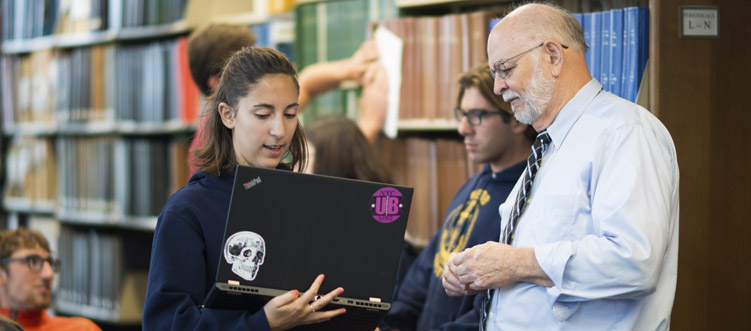
FRESHMAN YEAR
HU1: TECHNICAL COMMUNICATION
Instruction and practice in oral, written, and graphical communication: oral and written reports, letters, summaries, graphs, and figures. Exercises prepared in conjunction with courses in introductory naval architecture and other courses. Two hours per week in the first semester.
HU2: POLITICAL PHILOSOPHY
A historical and philosophical analysis of the major political theorists of the Western Tradition beginning with the birth of philosophy among the ancient Greeks. Major thinkers treated in this course include Plato, Aristotle, Machiavelli, Hobbes, Locke, Rousseau, Burke, et al. Some of the key themes considered include theory of human nature, the concepts of law, justice and authority, the idea of the “good” state, and the notion of human happiness as it relates to the socio-political environment. Three hours per week in the second semester.
SOPHOMORE YEAR
HU3: THE WESTERN CULTURAL TRADITION – I
The first in a two-course sequence in the history of ideas. This interdisciplinary course traces the development of the Classical and Romantic world views through examination of literature, painting, sculpture, music, and architecture. Through this course, students will become familiar with some of the major writers and artists and with some of the great works of western cultural achievement through the nineteenth century. Several required field trips. Three hours per week in the first semester.
HU4: THE WESTERN CULTURAL TRADITION – II
The second course in a two-course sequence in the history of ideas. This interdisciplinary course traces a number of developments that inform “Modernism” (the notion of modernité) through examination of literature, painting, music, architecture, and film. Through this course students will become familiar with some of the major writers, artists, and ideas of the late-nineteenth and the twentieth centuries. Several required field trips. Two hours in the second semester.
The art project assignment gives students the opportunity to recreate a famous painting or illustration.
JUNIOR YEAR
HUMANITIES/SOCIAL SCIENCES ELECTIVE
Students are allowed to choose a course from a list of classes in the humanities and social sciences. Courses will be taught by both full-time Webb faculty and by adjunct faculty who are experts in particular subject areas. Three hours per week in the first semester.
HU6: DEVELOPMENT OF AMERICAN GOVERNMENT
An examination of the development of the American national government from the mid-eighteenth century to the 1950s. Emphasis will be on how enduring values combined with changed circumstances to produce new roles for the national government. Two hours per week in the second semester.
SENIOR YEAR
HU7: ETHICS AND THE PROFESSION
This course explores some of the most influential ethical systems in the tradition of moral philosophy. The examination of these works is accompanied by class discussions that examine the practical application of these systems in the business of everyday life. Class discussions depart from the two crucial questions that form the basis of all moral inquiry: How should a person live? What do we owe to others? These questions will be explored through a variety of mediums including abstract philosophy and specific case studies drawn from the fields of science, engineering, business, and literature in order to develop the critical tools to evaluate the ethical codes that govern the students’ profession. Three hours per week in the first semester.
HU8: PROFESSIONAL PRESENTATIONS
The Professional Presentations class has two major goals—(1) short term: to prepare seniors to present their thesis work to the faculty, staff, and student body at the end of the spring semester, and (2) long term: to prepare students to be able to do high quality presentations as required in subsequent professional and/or academic settings.
Professors Gallagher, Scott, Werner, and Wiggins
This division includes those courses that pertain directly to marine machinery. The sequence begins with an introductory survey of propulsion and auxiliary systems. In the following years, detailed studies of machinery and systems are undertaken, including design aspects of steam generators, steam and gas turbines, diesel engines, heat exchangers, power transmission systems, main engine support systems, piping systems, HVAC systems, and control systems. The concepts of system integration, configuration management, and rational evaluation of alternative approaches are stressed.
The sequence culminates in a project in which the students prepare an outline proposal for a complete power plant for a specific application and undertake an investigation of its economic merit in comparison with a group of likely alternatives.
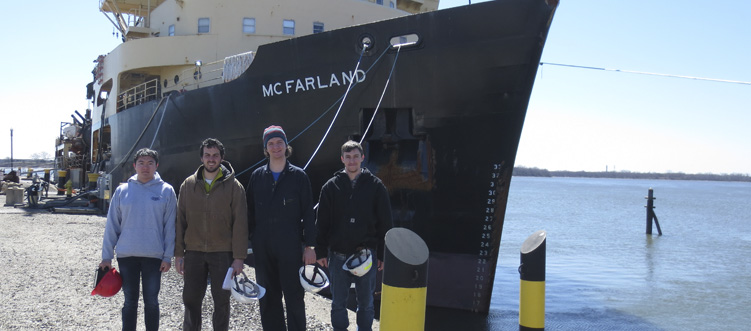
FRESHMAN YEAR
ME1: INTRODUCTION TO MARINE ENGINEERING SYSTEMS
This course presents the fundamentals of marine propulsion systems in which the overall needs of ship board powering are described, followed by a detailed discussion of steam, diesel, gas-turbine, and nuclear-powered prime movers. Students gain an understanding of the components and their function in each of these types of propulsion. A lab component of the course requires the students, in small groups, to run a steam plant in the marine engineering lab and to disassemble and reassemble a small diesel engine. The course begins the marine engineering program and provides background to students for their sophomore sea term. Two hours per week in the second semester.
SOPHOMORE YEAR
ME2: MARINE ENGINEERING SYSTEMS COMPONENTS
This course builds on the Introduction to Marine Engineering Systems (ME1) course and presents the fundamentals of system components and the auxiliary shipboard systems that these components produce. Components discussed include pumps, fans and blowers, compressors, valves and piping, heat exchangers, and purifiers. Auxiliary systems presented include fuel, compressed air, bilge and ballast, potable and cooling water, sanitary and sewage, HVAC and refrigeration, hydraulics, steering machinery, deck machinery, and safety systems. The course includes hands-on experiences and field trips to visit ships and other marine facilities. To help students prepare for their sophomore sea term, the course also includes information on basic shipboard first aid, firefighting, lifesaving, personal safety, and life at sea.
ME3: MARINE ENGINEERING MACHINE DESIGN
This course involves the design of specific machine elements such as shafts, gears, couplings, clutches, brakes, screw fasteners, and bolted joints. It applies the theory from the Strength of Materials course to practical problems in machine design. In addition, dynamic and fatigue stress analysis are introduced. Marine examples are used for the various elements, such as marine gearing and shafting. Three hours per week in the second semester.
JUNIOR YEAR
ME4: MARINE ENGINEERING APPLIED THERMODYNAMICS
The course consists of three distinct, related parts. Part one deals with the thermodynamic design of a combined steam turbine/gas turbine system. Design trade-offs and optimization are included. Part two deals with the design of the steam turbine from part one. Consideration of both thermodynamics and fluid mechanics are included. Part three provides coverage of heat transfer. One-dimensional steady and unsteady conduction and the empirical approach to convection are discussed. Brief coverage of radiation is provided. This part of the course culminates with the design of one of the heat exchangers in a COGAS plant. Design trade-offs and optimization are included. Three hours per week in the first semester.
ME5: SHIP AUXILIARY SYSTEMS DESIGN
This project-oriented course covers the design of shipboard auxiliary, mechanical systems building on the previous marine engineering courses and the students’ examination of systems while on board ships. The principles of fluid flow, thermodynamics, material science, and stress analysis are applied to design piping, hydraulic, and heating, ventilation, and air conditioning systems for marine applications. Throughout the design work, consideration of the relevant regulatory requirements and definition of system requirements are emphasized. To support complete design functionality, the course introduces monitoring and control systems, instrumentation and instrument response, feedback controls, and event driven or sequential process control. Four hours of class per week during the second semester.
SENIOR YEAR
ME6: SHIP PROPULSION SYSTEMS
This course includes a detailed analysis of diesel engines, a review of gas turbines, and completion of a machinery plant design for the vessels used in the Ship Design sequence. This design exercise draws on all the prior marine engineering courses as well as the student’s shipboard experience, in that all the propulsion and auxiliary equipment items are selected from vendor information, and the related machinery systems are designed to support them. A lab sequence involving hands-on work with low-speed and high-speed diesels is included. Four hours of class and two hours of laboratory per week in the first semester.
Professor Goloubeva
Mathematics is an analytical tool used in all science and engineering courses. At the same time, by its very nature, mathematics is an abstract science. Mathematics at Webb is presented with the focus on applied mathematics, a branch of mathematics which is drawing on the physical world for its motivation, developing abstract concepts to refine the physical ideas, and finally applying those abstractions to mathematical modeling and better understanding of the phenomena of nature. Many Webb students go on to graduate work involving higher mathematics, and it is a strong objective of the mathematics program to prepare them well for this work.
FRESHMAN YEAR
MA1: MATHEMATICS I – CALCULUS I
This is an introductory course whose main goals are to fill in the background of students who have already had an exposure to calculus in high school, to deepen their understanding of the material, and to develop their ability for abstract reasoning and mathematical modeling. The course starts with a discussion of vectors in the plane and in space, and basic vector operations, including dot and cross products. The course continues with a review of the real number system and inequalities, algebra of complex numbers, and the theory of elementary functions such as exponentials, logarithms, trigonometric functions, inverse trigonometric functions, hyperbolic functions and their inverses. The topics covered include limits, continuity, derivatives of functions of one variable, application of derivatives to curve sketching and to simple real-life problems involving related rates, and optimization. The mean value theorem is covered. Linear and Taylor polynomial approximations are discussed and applied to limits via L’Hopital’s rule. The course includes a discussion of basic numerical methods such as method of bisections and Newton’s method. The course concludes with a brief discussion of integration. To develop students’ ability for abstract reasoning and to reach a deeper understanding of the material, the discussion often includes proofs. The class meets four hours per week in the first semester.
MA2: MATHEMATICS II – CALCULUS II
The course starts with a discussion of integration, integration techniques, and applications of integrals. The topics of discussion include the Riemann Integral, the review of the basic techniques of integration such as substitution, integration by parts, partial fraction decomposition, and trigonometric techniques of integration. The course covers applications of definite integrals to simple problems involving area between curves, arc length, volume, projectile motion, work, and center of mass. The course continues with a discussion of the theory of parametric equations, plane curves, and polar coordinates. The concepts of calculus are extended to curves described by parametric equations and polar coordinates. In this course the geometry of three-space is covered more extensively than in Mathematics I. Cylindrical and spherical coordinates are introduced. Emphasis is placed on visualization and graphical representation of surfaces in space.
This course contains most of the calculus of functions of several variables and includes concepts of limits and continuity of functions of several variables, partial derivatives, tangent planes and linear approximations, gradients, differentials and directional derivatives. In this course we introduce the mathematical basis for finding the maximum or minimum of functions of several variables. Optimization problems for functions of several variables are introduced.
The discussion includes constrained optimization and the method of Lagrange multipliers. The course also includes a brief introduction to linear algebra, which covers the rudiments of matrix algebra. Determinants are also introduced here. The course concludes with a unified discussion of real infinite series. The class meets four hours per week in the second semester.
SOPHOMORE YEAR
MA3: ENGINEERING MATHEMATICS I
Two separate components of the course: the first component starts with the discussion of applications of partial and directional derivatives, covers the theory of vector-valued functions, and multiple integrals. The second component is a beginning of the basic course in differential equations with a small linear algebra component.
MA4: ENGINEERING MATHEMATICS II
There are essentially three separate components of the course. The first component involves a discussion of multiple integrals and vector calculus. This material can best be described as the mathematics needed to study fluids. The course covers the theory of vector-valued functions. Multiple integrals are covered extensively. Emphasis is placed on transformation of space/coordinates and the role of the Jacobian. The concepts of vector and scalar fields, curl, and divergence are introduced from a very physical point of view, as are line and surface integrals. The three major theorems of vector calculus – Green’s theorem, Stoke’s theorem, and the Divergence (Gauss’) theorem – are covered. A strong emphasis is placed on physical interpretation. This material is highly visual and makes extensive use of Maple to illustrate the concepts.
The second component of this class involves complex variables. This component covers the basic arithmetic and geometry of the complex number system. Then the calculus of functions of complex numbers is studied, including the Cauchy-Riemann equations and the implications for harmonic functions. Complex exponential, trigonometric, and logarithmic functions are defined and studied. There is a brief treatment of conformal mapping. In addition, standard integral procedures are discussed.
The third component of this course covers the remaining essential parts of linear algebra and differential equations. The class works more extensively with matrices, matrix functions, and the calculus of matrix functions. Then it discusses methods of solution of systems of first-order linear equations, eigenvalues and eigenvectors, and methods of solution of systems of differential equations. The course meets four hours per week in the second semester.
JUNIOR YEAR
MA5: PROBABILITY AND STATISTICS
This course begins with an introduction to probability theory, including set theoretic and combinatorial concepts. This is followed by treatments of discrete random variables and distributions and continuous random variables. Generating functions are discussed at some length. Particular emphasis is placed on the Rayleigh and Weibull distributions, which are applied subsequently in the Ship Dynamics course as models of wave spectra and are also encountered as models of the manufacturing process. The latter third of this course addresses the application of statistical methods to engineering experimentation, beginning with an introduction to estimation and hypothesis testing and culminating with an overview of experiment design. The course meets four hours per week in the first semester.
Professors Gallagher, Golden, Onas, Royce, and Werner
The fundamental laws of buoyancy, stability, and strength are fully considered, as these have universal application to all kinds of ships and floating structures. The study of naval architecture is begun in the freshman year in order to familiarize the student as early as possible with ship and shipbuilding terms, technical facets of ship analysis and design, shipyard arrangements, and general methods of ship construction. Major subjects covered are hydrostatics, stability, ship structure, ship dynamics, resistance, and propulsion. Knowledge gained is subsequently applied in the design courses.
Owing to the wide variety of types and sizes of ships in service at the present time, it is inevitable that a certain amount of specialization is necessary for their design and construction. It is the aim of the courses to cover the fundamentals of naval architecture in the time available, so that the specialized study of any one of a number of particular types or classes of ships may be left to the individual who, after graduation, is especially concerned with them.
FRESHMAN YEAR
NA1: INTRODUCTION TO NAVAL ARCHITECTURE
This course presents an overall introduction to the maritime industry. The broad spectrum of ship types and industry sectors – from sailing yachts and tugs to mammoth tankers and military vessels, from ship design and construction to marine regulations and finance – are described. The main principles of naval architecture are discussed, and students are given an opportunity to practice each of these principles in a hands-on, project-based environment. Students are guided through each project while also being introduced to the engineering method, which includes elements on design, group work, project planning, and time management, and helps build a foundation for continued success throughout their engineering education. The final part of the course is a direct preparation for the first winter work period including hands-on experiences and field trips to visit shipyards and other marine facilities.
SOPHOMORE YEAR
NA2: SHIP STATICS
This course in hydrostatics of ships covers buoyancy, weights, metacenters, and stability at small and large angles of heel and trim. Stability after damage and hydrostatic considerations in drydocking and grounding are treated. Stability regulations are discussed along with the concept of limiting vertical center of gravity. In the project part of the course, curves of form are calculated for a small vessel with much of the work done on a computer. Students are introduced to hydrostatic software in order to calculate the cross curves of stability for the same hull form.
JUNIOR YEAR
NA3: SHIP RESISTANCE AND PROPULSION
The components of a ship’s resistance and the effects of important hull parameters are discussed as well as the special problems of bulbous bows and hull appendages. Full-scale prediction of ship resistance by means of model tests, standard series, and regression analyses are examined and evaluated. Wake fraction, thrust deduction, and propulsive coefficient are presented. The design and sizing of screw propellers and waterjets are presented.
NA4: SHIP STRUCTURES
The course introduces modern ship structural analysis and design techniques. The loading experienced by ship structures is outlined. The engineering properties of shipbuilding materials and typical ship structure arrangements are described. The role and use of classification society rules in structural design are explored. Methods for the analysis and design of the hull girder, beams, girders, unstiffened and stiffened plate panels are introduced. Failure due to yielding and buckling are considered. Both analytical and finite element methods for analysis are presented and applied to typical ship structural elements. Two hours of class and two hours of laboratory per week in the second semester.
SENIOR YEAR
NA5: SHIP DYNAMICS
In the first part of this course, the student applies knowledge of rigid-body dynamics, vibrations, and hydrodynamics to the study of seakeeping, which addresses the ship’s response behavior in ocean waves. In the second part, the ship’s maneuvering theory in calm water is developed. The seakeeping part starts with wave statistics. The wave environment is described mathematically first using the regular wave theory and then is expanded to a stochastic or probabilistic description of the seaway using wave spectrums and scatter diagrams. The ship equations of motion are developed for seakeeping, and calculation of the wave excitation force, added mass and radiation damping are introduced, based on strip theory and velocity potential formulations. The response of a ship to ocean waves is treated, first to a single wave train and then to a wave spectrum using linear superposition principles. Calculations are compared to scale model test results. Analytical and numerical test results are validated with published seakeeping data. Seakeeping criteria are discussed, including critical vessel responses such as roll, deck wetness, slamming, and impact loads. The equations of motion for maneuvering are developed in the second part of the course. Analytical and experimental methods of determining maneuvering coefficients are presented. Controls-fixed stability is discussed in detail and calculation of stability index is carried-out. The theory of ship turning is presented with calculation of turning parameters, emphasizing the limitations of linear theory. An introduction to rudder design follows and methods to evaluate the rudder performance characteristics are introduced. Three hours of class per week in the first semester.
NA6: ADVANCED COMPUTATIONAL TOOLS FOR NAVAL ARCHITECTS
This course reviews the general engineering process for problem-solving in the context of recognizing appropriate simplifying assumptions and their impact on the fidelity of the desired solution. Effective use of Computational Fluid Dynamics and Finite Element Analysis software requires that the user understand the underlying assumptions. This course will investigate problems with increasing complexity and discuss best practices at each step of the analysis. The goal is that the student is able to critically and effectively use commercial CFD and FEA software.
NA7: MARINE TRANSPORTATION
This course gives an overview of marine transportation systems, including tankers, breakbulk, dry bulk, and container lines from a business standpoint. The fundamentals of maritime economics and financial management are presented, including a fleet analysis based on the ship design project begun in the Ship Design I course. Case studies and a research paper are used as the primary learning tools. Management techniques and linear programming are included. Three hours of class per week in the second semester.
Professor Wiggins
Under this heading are grouped the courses in physics, chemistry, and materials science. These courses introduce scientific methods and provide training in the fundamentals upon which engineering knowledge depends. The courses in chemistry and materials science prepare the naval architect and marine engineer to cope with the materials used in shipbuilding.
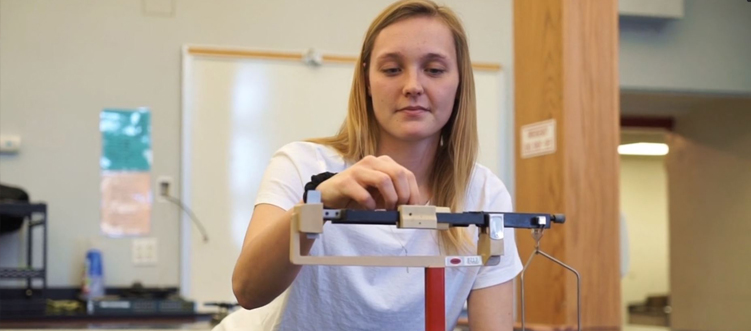
FRESHMAN YEAR
SC1: CHEMISTRY
This is an introductory course in general chemistry. Topics covered include stoichiometry, inorganic reactions, ideal gases, condensed phases, chemical equilibrium, and acids and bases. Solubility, thermochemistry, and electrochemistry are also covered. Three hours of class per week and two hours of laboratory every other week in the first semester.
SC2: PHYSICS I – ELEMENTARY MECHANICS
The course provides a rigorous introduction to elementary mechanics. Vector algebra is introduced and used where appropriate. Newton’s Laws of Motion are introduced and applied to the kinematics and dynamics of particles and rigid bodies both for linear and rotational motion. The subjects of forces on bodies, momentum, work, and energy are described and applied to problems. Three hours of class per week in the first semester.
SC4: PHYSICS II – SIMPLE HARMONIC MOTION, LIGHT, AND SOUND
This course is an introduction to wave theory starting with elastic behavior, simple harmonic motion, and mechanical waves, both transverse and longitudinal, as well as traveling and standing waves. Sound waves are studied, including three-dimensional waves and Doppler effect. The course concludes with an examination of geometric and physical optics including reflection, refraction, mirrors, lenses, diffraction, and interference. Two hours of class per week in the second semester. Supporting laboratory exercises are conducted in the Science Lab course.
SC3: MATERIALS SCIENCE
The structure-property-processing relationships of engineering materials are investigated. Emphasis is placed on understanding the general behavior and capabilities of the different types of materials. The primary focus of this course is on metals, especially steel. Major topics include crystal structures, including crystal imperfections; diffusion in solids; mechanical properties, including tensile, hardness, impact, and fatigue testing; work hardening and annealing; phase equilibrium; and heat treatment, including non-equilibrium transformations such as martensite. Other topics include introductory coverage of stainless steel, cast iron, polymers, and composite materials. Optimal use of materials in ocean-going systems is stressed. Three hours of class per week in the second semester. Supporting laboratory exercises are conducted in the Science Lab Course.
SC5: SCIENCE LAB
This course supports the Physics II and Materials Science courses through related hands-on laboratory exercises. While half the class is performing a series of physics experiments, the other half is performing laboratory exercises that explore material properties and behavior. Students alternate between the physics laboratory and material science laboratory on a weekly basis. Two hours per week during the second semester.
SOPHOMORE YEAR
SC6: PHYSICS III – ELECTRICITY AND MAGNETISM
This course covers electrostatic forces, electric fields and magnetic fields. The concepts of current, resistance, capacitance and inductance are discussed, as well as the magnetic properties of materials. DC circuit analysis using mesh currents, node voltages and network theorems are introduced. The class concludes with transient analysis of DC circuits.
ES9: HYDRODYNAMICS
The fundamentals of ship hydrodynamics are introduced in the context of naval architecture and ocean engineering. Conservation of mass and linear momentum and the Navier-Stokes equations are revisited. Description of the flow and its visualization are discussed, and the mathematical formulation of continuous flows is presented. The use of potential flow in understanding the fundamentals of fluid flow around a ship is included. Boundary layer theory is developed in relation to hull forms and lifting surfaces. An introduction is made to Computational Fluid Dynamics (CFD) with its assumptions and limitations. Unsteady motion and the concept of added mass are introduced, and calculations are carried-out for simple and more complicated shapes. Lift and drag topics include NACA foil sections, lifting line theory, Joukowski airfoils, and Glauert’s method for optimum planform. Green’s functions are introduced, for simplified potential theory problems. Potential theory is further developed for added mass and damping on a circular cylinder. Forces on a column are examined using Morrison’s equation.
Professors Gallagher, Golden, and Onas
These three courses synthesize the course material taken to date—especially in the naval architecture and marine engineering curricula—and represent the capstone sequence of the Webb academic program. Both team and individual project work characterize these courses as do analysis and development of presentation skills.
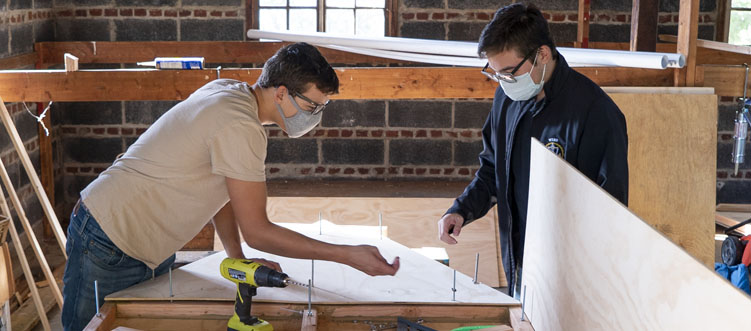
JUNIOR YEAR
SD1: SHIP DESIGN I
In this course, students are introduced to the ship design process, from the concept/feasibility study stages right through to detail design. Ship design as a decision-making process is discussed, as is the idea that design includes a number of factors including estimation, tradeoffs, synthesis, risk assessment, aesthetics, iteration, optimization, and learning. There are many challenges to be faced during a design, and students are introduced to some of the problem-solving tools that can be used to achieve a stated goal. With this information, and using the knowledge and experiences they’ve gained from earlier courses and internships, small teams of students undertake the initial design of a small vessel of their choice, being led through the iterative design process with the aid of accompanying lectures. Topics discussed include parametric analysis, hull sizing, space and general arrangements, estimation of weights and centers, structural arrangements, stability, powering, propulsion, and regulations. The student-led teams are guided by faculty and industry mentors who have been identified as experts on each of the specific vessel types being designed, which gives students the opportunity to practice their communication skills and provides networking opportunities. Written design reports are produced as are oral presentations of the students’ designs to a panel of invited industry professionals. Following the completion of the small vessel design project, the design problem statement for a large, oceangoing ship is developed, and initial conceptual sizing is performed. This oceangoing ship design will be developed further in subsequent courses (SD2, SD3, NA6, and ME6).
Visit our Small Vessel Design Project pages for student project examples.
SENIOR YEAR
SD2: SHIP DESIGN II
The preliminary design to meet the specifications developed in SD I is completed by each student in several projects over the semester. A general arrangement of the vessel, along with a powering analysis, is the first step. A lines plan is then developed, based on the preliminary hull from the first step. Next, another iteration of the arrangements is made, and finally, the intact and damaged stability are analyzed. Two hours of class and four drawing-room hours per week in the first semester.
SD3: SHIP DESIGN III
The preliminary design of the containership is concluded from the previous semester in Ship Design II. Classification rules are revisited with a focus on understanding the terminology and the relevant structural requirements applicable to the project. Hull girder longitudinal strength requirements are evaluated based on classification society rules and quasi-static loading analysis using a longitudinal weight distribution method and general hydrostatics software. Using two representative ship operating condition and the calculated loads, the students are asked to design the midship section of a ship and verify that the longitudinal structure meets classification society requirements. Design of transverse structural members such as bulkheads and/or deep web frames is carried out, with verification that they meet classification society requirements. The structural performance of the hull girder is then analyzed. Finite element analysis (FEA) software is used in the structural design. Material selection, structural weight, producibility, and access for inspection and maintenance will be emphasized during the design.
OT1: ENGINEERING ECONOMICS
Coverage of the principles of engineering economics, including compound interest, present worth, annual cash flow, rate of return, depreciation, taxes, and replacement analysis. One hour per week in the first semester senior year.
TH1-3: THESIS
In order to qualify for graduation, each student in the senior year is required to prepare and submit a written thesis, in or related to the field of naval architecture or marine engineering under the direction of a member of the faculty. Senior theses may be individual or team efforts. In addition to a written thesis, seniors are required to present orally the results of their thesis efforts to the assembled student body, faculty, and administration in the late spring of their senior year.
SENIOR SEMINAR
The Senior Seminar, conducted during the final semester, is designed to introduce the seniors to the human factors, business considerations, management techniques, and analytical concepts they may expect to encounter after graduation. Seminar leaders are drawn from the Webb staff and from business and industry. Subjects range from labor-management relations to systems engineering. Content will vary from year to year dependent both on student interests and on developments in the area covered.
SPECIAL TOPICS
These three-credit courses represent the two opportunities for electives at Webb. The first is a humanities or social science course chosen by the students from a list of suggestions provided by the Dean and augmented by the students themselves. If sufficient interest in a topic exists, distinguished members of academia and/or industry are sought to teach the courses. These courses are intended to broaden the students’ view of the world and are offered during the fall semester of the junior year, three class hours per week.
The second course is a technical elective again chosen by the students from a list provided by the Dean and augmented with their suggestions. This course provides an opportunity for Webb to engage distinguished visiting faculty to share their particular expertise and real world experience with interested students (and faculty).
These courses provide a way to either sharpen the focus of a student’s program or to expand the scope of his/her undergraduate experience. This course is offered three class hours per week in the final semester of the Webb academic program.
PRACTICAL WORK (aka WINTER WORK)
Webb will assist in securing positions with advice to the students and the establishment of liaison with various companies. The sequence usually consists of working as a helper mechanic in a shipyard the first year; as a cadet/observer in the engine room of a ship the second year; and in a professional capacity as an engineer in the industry the third and fourth years. The students are paid at the going rate of their jobs, sufficient to support themselves while away from school. Housing can usually be located through the company employment departments.
Each student is required to present a technical report on the practical work undertaken during each of the four winter intersessional periods. The immediate supervisor is also invited to comment on the student’s performance. Additionally, a Sophomore Sea Term Project is required following the work term spent aboard ship.
ENGINEERING VISITS
Visits of inspection are made by individual classes to nearby shipbuilding, dry docking and repair yards, other engineering plants, and to vessels in the vicinity. These visits are arranged through the courtesy of the managing officials of the companies.
In order to develop their powers of observation and to improve their ability to write technical reports, the students are required to submit brief reports of their observations immediately after each visit.
PROFESSIONAL SOCIETY MEETINGS
During the spring semester, the entire Junior class attends the Offshore Technology Conference (OTC) in Houston, Texas. The entire Senior class attends the Society of Naval Architects and Marine Engineers (SNAME) conference during the fall semester. Students regularly attend local professional society section meetings throughout the year.

